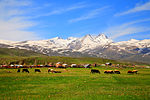Search results
Appearance
There is a page named "Areni-1 winery" on Wikipedia
- Areni Wine Festival)regions of the world. In particular, the oldest known winery, Areni-1 winery, was found in Armenia's Areni region, which is still known for its wine production...41 KB (4,605 words) - 12:04, 10 January 2025
- landmarks and tourist attractions in Armenia including the Areni-1 cave complex and Areni-1 winery of the Chalcolithic period, the 8th-century Tanahat Monastery...32 KB (2,927 words) - 03:58, 2 March 2025
- of about 6000 BC. The oldest winery in the world (dating to 4100BCE) was found in the Areni-1 cave, which lies in Areni, Armenia. Grape pips dating back...46 KB (5,359 words) - 09:35, 3 April 2025
- culture dates from 8,000 years ago in Georgia. The oldest known winery, the Areni-1 winery, was found in Armenia and dated back to around 4000 BC. By the...41 KB (4,078 words) - 07:13, 18 February 2025
- Eastern Anatolia and northern Iran. The earliest known winery, from 4100 BCE, is the Areni-1 winery in Armenia. A 2003 report by archaeologists indicates...99 KB (9,890 words) - 18:50, 3 April 2025
- in the site of the Areni-1 winery, a 6,100-year-old winery discovered in 2007 in the Areni-1 cave complex in the village of Areni in the Vayots Dzor province...6 KB (459 words) - 03:08, 24 December 2024
- evidence of deliberate winemaking is from excavation at sites like Areni-1 winery in what is now the Vayots Dzor Province of Armenia. This site, dating...20 KB (2,726 words) - 12:32, 10 February 2025
- Boris Gasparyan, found the 5,500 years old shoe in and the oldest winery in Areni of which Areshian said: For the first time, we have a complete archaeological...10 KB (1,099 words) - 11:16, 23 January 2024
Assembly. 2011 January 10: Areni-1 winery, discovered in Armenia's Vayots Dzor province in 2007, confirmed to be the oldest winery in the world. 2011 March...
70 KB (6,797 words) - 17:43, 18 March 2025
ISO 3166-1:AM)
dating to about 4000 BC. Archaeological surveys in 2010 and 2011 at the Areni-1 cave complex have resulted in the discovery of the world's earliest known...
221 KB (20,860 words) - 13:43, 3 April 2025
Archaeology of Armenia (section Earliest known winery)
excavations of the Areni-1, the cave where the 5,500 years old leather shoe was found, announced that they found the world's oldest known winery, which could...
24 KB (2,683 words) - 00:14, 8 August 2024
site of the remnants of crushed grapes. The oldest-known winery was discovered in the "Areni-1" cave in Vayots Dzor, Armenia. Dated to c. 4100 BC, the...
68 KB (7,375 words) - 08:54, 24 March 2025
Armenian wineries are concentrated in the Areni region (district of Vayots Dzor). Armenian wine is mostly made from local varietals, such as Areni, Lalvari...
103 KB (10,396 words) - 12:57, 25 January 2025
Retrieved July 3, 2020. "Diversity, but also inclusion – Julia Coney ⋆ ARENI Global". ARENI Global. March 31, 2020. Retrieved July 3, 2020. Morales, Christina...
15 KB (1,499 words) - 12:26, 8 March 2025









